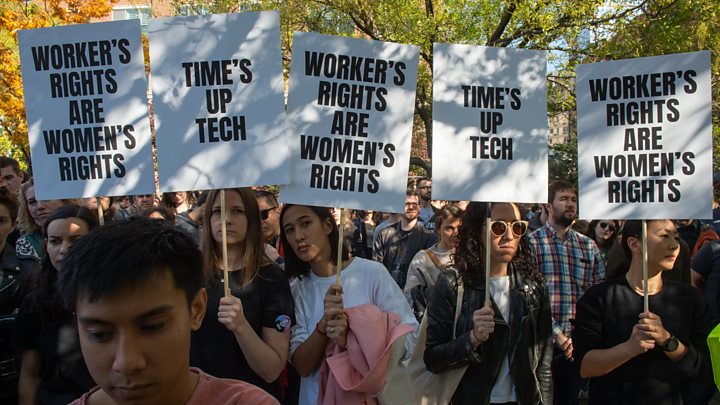Google Walkouts: Inconvenience Causes Change
December 3, 2018
As long as there have been unfair working conditions, there have been protests. Granted, the protests now are much less violent than in the past, but the effect is still grave. The March 14 School Walkout, Women Factory Walkouts of 1834 and 1836, and the 1968 East Los Angeles Walkouts are all examples of successful walkout protests. Each succeeded in getting their main message across to the public and/or their employers. One common cause of protests in workplaces is the treatment of women, specifically how companies treat sexual harassment misconduct. According to the New York Times, 3,000 employees walked out of Google to protest the unfair sexual misconduct rules in place. The protesters got the message across, but what was the main cause of this infringement?
Google, a multi-billion dollar company, is being run by men who have sexual harassment allegations against them. According to The Seattle Times, “The protests were sparked in part by last week’s New York Times story detailing allegations of sexual misconduct by the creator of Google’s Android software, Andy Rubin, who reportedly received a $90 million severance package in 2014 after Google concluded the accusations were credible.” Google continues to protect men who claim to “misread situations” and harass women, yet there should be no situation in the workplace where their actions are acceptable. It is horrifying that a man can harass a woman, and walk away with an absurd amount of money. According to Business Insider, the CEO of Google, Sundar Pichai, said, “Moments like this show that we didn’t always get it right,” in reference to a New York Times article explaining the details of the allegations and walkouts. It is especially crucial that billion-dollar companies correct their wrongdoings. The fact that it has taken years for these issues to arise is disreputable.
Additionally, women being taken seriously in office jobs, especially engineering, has been an uphill battle. According to Forbes Magazine, “The study shows that 30% of women are skeptical that the changes taking place around sexual harassment policies and programs are effective, and women are twice as likely as men to say that it would be risky or pointless to report an incident.” As if coming forward with a traumatic experience is not stressful enough, the system implemented by these companies can force victims into submission. Google currently has forced arbitration, a common practice with companies that want to avoid legal consultation. Forced arbitration is when two parties hold a hearing without lawyers or legal interference, but this method is forced upon one/both parties. According to Sam Levin, “This system can silence victims with non-disclosure agreements, conceal labor violations from the public, and protect serial offenders.”
A way to avoid these conflicts is to change how sexual harassment is handled within the company. After the walkout, there were demands for change made. According to BBC, “They are: A commitment to end pay and opportunity inequality. A publicly disclosed sexual harassment transparency report. A clear, uniform, globally inclusive process for reporting sexual misconduct safely and anonymously. The elevation of the chief diversity officer to answer directly to the CEO, and make recommendations directly to the board of directors. The appointment of an employee representative to the board. An end to forced arbitration in cases of harassment and discrimination for all current and future employees.” These options are crucial for improvements in the conditions for women in the workplace. The fact that these were not in place beforehand is frightening. A multi-billion dollar company has gotten away with underlying sexist policies for years.
These concerning factors all led to the monumental walkout on November 1, which continues to inspire walkouts at other companies. For example, according to The Seattle Times, “The companywide protests at sites from Tokyo and Singapore to London and New York reflect a growing #MeToo-style backlash against the treatment of women at heavily male-dominated tech firms in Silicon Valley and elsewhere.” Protests like this will strengthen the original women’s march, bringing in more participants and news coverage. These components will hopefully bring awareness to the struggles of working women (and women overall) face on a day to day basis. Although there have been several improvements for working women since the beginning of the suffragette movement, there is still much more progress to be made.
It is clear that blatant sexism has been the underlying theme of this company for longer than an acceptable amount of time. These walkouts demonstrate that workers will not be undermined, and unfair treatment will not be ignored.













Lauren Bulanek • Dec 10, 2018 at 1:15 pm
For an Op/Ed article, this piece is very factual and informative. The writer manages to give their perspective in a fair manner that is respectful. This is the first article I have seen about the walk outs too. There isn’t much on the news about it. Despite the little coverage, the writer uses accurate sources. It was a very good read.